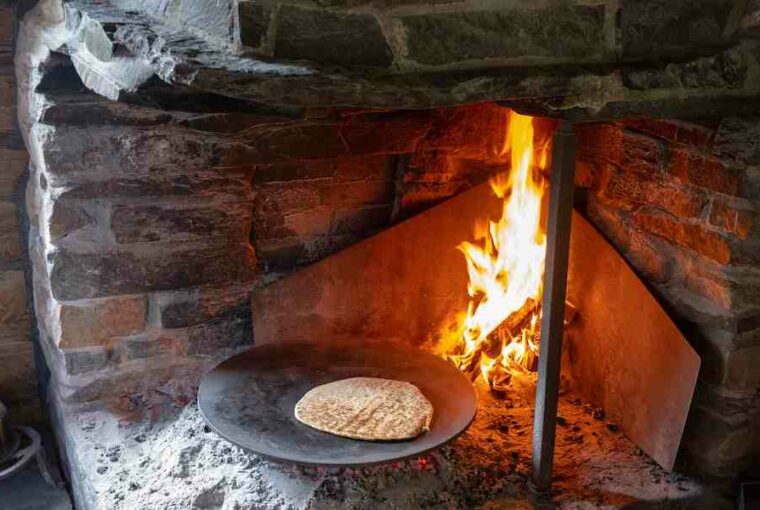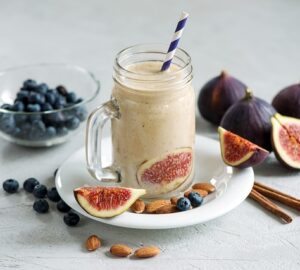The Indian subcontinent is home to many unique and delicious foods. Indian food is well-known for its use of unique spices, seasonings, and flavor profiles. Many people are familiar with several popular dishes from this region, including chicken tikka masala, samosas, and naan bread. Naan is a type of leavened flatbread that is common in many Indian cuisine dishes. This type of bread is often used to soak up the delicious juices from curry sauces; however, it can be used in a variety of ways to add an exciting twist to your next meal. There are many variations of naan bread, but most versions are similar to an English muffin or pita bread in appearance and texture. In this article, we’ll dive into the details of what makes naan bread so special. Keep reading to learn more about how this flatbread fits into a healthy diet plan and whether it has any negative side effects if you eat it frequently.
Is Naan Bread Healthy?
Naan bread is not as healthy as other types of bread, but it is still a good source of carbohydrates, protein, and fiber. Naan bread is made with white flour, which is a high-glycemic food that can cause blood sugar levels to spike. However, naan bread also contains whole grains, which help to slow the absorption of glucose into the bloodstream. Naan bread is also a good source of protein and fiber, both of which are important nutrients for maintaining good health.
Why Is Naan Bread Considered A Healthy Food?
Naan Bread Is Low in Calories
Naan bread is a low-calorie food. One slice of naan bread has only about 30 calories, which is about half the amount of calories found in a serving of whole-wheat bread. This type of bread also contains less than 5 grams of fat, which is significantly lower than the amount found in a serving of whole-wheat bread.
Naan Bread Is Low in Sodium and High in Fiber
Naan bread contains very little sodium, which is a common concern for many people with high blood pressure, or those who are trying to lower their sodium intake for health reasons. In fact, this type of flatbread contains less than 100 milligrams (mg) per slice, making it an excellent choice for people who have high blood pressure or who are trying to reduce their sodium intake. It also contains a high amount of fiber per slice, which helps to keep you feeling full and satisfied long after you eat a serving of naan bread.
Naan Bread Is High in Potassium and Vitamin B-6
Naan bread is high in potassium, which is a mineral that helps to regulate blood pressure, control heartbeat, and maintain the health of your nervous system. This type of flatbread also contains high amounts of vitamin B-6, which plays an important role in energy metabolism and the formation of red blood cells. It’s best to consume foods that contain these two nutrients together so that you can get the most benefit from both nutrients at once.
Naan Bread Is High in Calcium, Iron, and Niacin
Naan bread is high in calcium per slice and contains a small amount of iron per slice as well (about 1 mg). These nutrients are important for bone health because they help to strengthen your bones by promoting healthy bone growth and preventing brittle or weak bones from forming. Naan bread also contains small amounts of niacin, which is an important nutrient for maintaining the health of your nerves and brain.
Naan Bread Is Low in Cholesterol and Carbohydrates
Naan bread is low in cholesterol and carbohydrates, which makes it a healthy choice for diabetics who take medication to control their blood sugar levels. The bread also contains a small amount of dietary fiber per slice, which means that it’s not very high in calories or carbohydrates. While naan bread does contain small amounts of sodium and fat, it doesn’t contain any trans fats or cholesterol, making it a good choice for people who want to limit their intake of these nutrients in their diet.
Nutrition Facts For Naan Bread
What is Naan Bread?
Naan bread is a type of leavened flatbread that is common in many Indian cuisine dishes. This bread is often used to soak up the delicious juices from curry sauces; however, it can be used in a variety of ways to add an exciting twist to your next meal. There are many variations of naan bread, but most versions are similar to an English muffin or pita bread in appearance and texture. In this article, we’ll dive into the details of what makes naan bread so special. Keep reading to learn more about how this flatbread fits into a healthy diet plan and whether it has any negative side effects if you eat it frequently.
What Makes Naan Bread Special?
There are several reasons why naan bread is considered so special by the people who enjoy eating Indian food and other cuisines that use this type of flatbread as a staple part of their cooking process. For starters, naan bread is made with a leavened dough that is made from flour and water. The addition of yeast to this dough helps to create a bread that rises as it bakes. This type of bread is often baked on a hot stone, which helps to give the naan its unique crispy texture. In addition, this type of food has become popular for its use in many types of Indian curry dishes. This type of bread is also used to soak up the delicious juices from these dishes, making it an ideal choice for people who enjoy eating low-carb diets.
Popular Varieties of Naan Bread
There are several popular varieties of naan bread that are available in most grocery stores, including Plain Naan Bread – Which is the base version of naan bread. The dough for this version is made from flour and water and is then shaped into a flat round loaf. This type of bread can be used to make many different types of dishes, including sandwiches and wraps. It can also be baked on a hot stone to create a crispy crust, which makes it perfect for use in all types of Indian cuisine dishes.
Health Benefits Of Eating Naan Bread
Naan Bread Provides Fiber
Naan bread is a whole-grain product that provides a nice dose of fiber. The fiber found in naan bread helps to keep you feeling full longer while also helping to lower the risk of heart disease and diabetes. This type of bread also contains protein, which helps to keep you feeling fuller longer.
Naan Bread Is Low-Carb
One drawback to eating naan is that it’s low-carb, meaning it has fewer carbs than other types of bread. However, this type of bread can still be a great option for people who want to eat foods that are low in carbs but not necessarily fat-free or low-calorie foods. This type of bread is often made with flour and starches that contain less than 8 grams of carbohydrates per slice; therefore, it can fit into many diets without making them too restrictive. Most people will enjoy eating this type of flatbread due to its taste and texture. Some people may feel that naan bread is too high in carbs for their diet plan, but it can be a great choice for those who want to eat bread or grains without going too low in carbohydrates.
Naan Bread Is Fat-Free
Naan bread is not a high-fat food, which can be a good thing if you are trying to lose weight. This type of flatbread is often made with oil and butter; therefore, it won’t raise your total fat intake significantly. However, some people may feel that this type of bread has too much fat for their diet plan and may prefer to limit the amount of fat they eat on a regular basis. People who don’t want to cut out all fats from their diet plan can still enjoy eating this type of flatbread as long as they eat it in moderation and keep it away from sauces or other foods that are high in fat.
Naan Bread Is Low-Calorie
One advantage to eating naan bread is that it is low in calories. One slice of naan bread contains only about 100 calories, which makes it a good choice for those who want to keep their calorie intake very low throughout the day. People can enjoy this type of flatbread as a high-protein snack or even as a meal replacement if they eat it with other foods that are lower in calories.
Side Effects Of Consuming Naan Bread Frequently
It is high in calories and fat
Naan bread is a very high-calorie food. One serving of naan bread contains over 300 calories and 14 grams of fat. This can add up to a significant amount of added calories if you eat it frequently. If you’re watching your weight, it may not be the best choice for you to consume this type of bread.
It can cause digestive issues if eaten regularly
Consuming lots of sodium in one sitting can lead to an upset stomach, cramping, diarrhea, or other digestive issues in some people. This is especially true for people who have underlying health conditions such as Crohn’s disease and celiac disease. If you suffer from cramps or other digestive problems after eating a lot of sodium, avoid eating too much naan bread until your symptoms subside for at least several days after your last meal with this type of bread in it.[1] For example, many people who have celiac disease have trouble digesting wheat, so it’s not a great idea to eat naan bread on a daily basis.
It is high in carbs and can lead to weight gain
Naan bread is very high in carbs. One serving of naan bread contains over 30 grams of carbohydrates, which is about 15-20% of your daily recommended value for carbohydrates.[2] This type of flatbread is also very high in calories and fat, which is likely why people often consume large amounts of this food item without thinking about the consequences. Consuming too many calories without enough nutritious foods can lead to weight gain over time. If you eat too much naan bread, you may be at risk of gaining extra pounds if you are not careful.
It can make you feel bloated after eating it multiple times per day
The reason that many people often eat too much naan bread is that it contains a lot of carbs, which can make you feel bloated after eating it multiple times per day. If you’re feeling bloated after eating too much naan bread, try breaking up your consumption of this flatbread by eating it less often or in smaller portions.
The Bottom Line
Naan bread is one of the most common flatbreads found in Indian cuisine. It is made with whole grains and a blend of spices. Naan is a healthy food option, thanks to its low-fat content and high level of fiber. It is a great source of B vitamins and magnesium, which are important for metabolism and bone health. Naan also contains iron and zinc, which help to support the immune system. While naan is high in calories and fat, it can be enjoyed as part of an occasional meal without adverse consequences. If you are a fan of Indian food, there’s no doubt that you’ve come across naan bread before. This popular flatbread is easy to find at most Indian restaurants, and it can be used to create a variety of delicious dishes.




